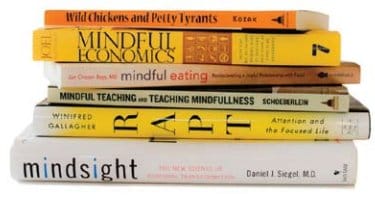The Teachings of Master Wuzhu (Columbia 2011) is a study and translation by Wendi Adamek of an obscure Chinese text attributed to Zen/Chan Master Wuzhu (714–774) and his community of disciples from Sichuan Province, China. Thought to have been lost, the current work derives from two Chinese manuscripts that were retrieved from the desert cave complexes at Dunhuang on the northern China frontier. The text is arranged as a series of dialogues wherein Master Wuzhu is engaged by various characters including politicians, soldiers, recluses, and fellow Chan masters and nuns. One of the few surviving texts from this formative period of Buddhism in China and the early development of Zen, Master Wuzhu’s teachings were controversial because his uncompromised teachings on the nonduality of “no-thought” and “formless practice” were considered radical at the time, though this later became a hallmark of Zen.
As we discover in The Hidden Life of the Sixth Dalai Lama (Lexington 2011), there are many portrayals of the Sixth Dalai Lama, Tsangyang Gyatso (1683–1706). Perhaps the most defined personality is that of a wino and womanizer, the image popularized among Tibetans by the poetic love songs attributed to him. What we have here however, in this translation by Simon Wickham- Smith, is a different Sixth Dalai Lama altogether. This intriguing biography written by an eighteenth-century Mongol scholar presents the Sixth Dalai Lama not as a drinker and poet, but as a solemn and sober Buddhist monk who lived the life of a wandering mendicant and spiritual teacher. Considered by some to be a fictitious account while others read it as authentic, this life story challenges common preconceptions of one of the most caricatured figures in Tibetan history.
Meditations of a Buddhist Skeptic (Columbia 2011) is B. Alan Wallace’s reflections on the emerging dialogue between Buddhism and science. Wallace, a senior voice in this conversation, calls for collaboration among scientists and contemplatives. However, he does this as a skeptic, with caution, suggesting that a true marriage of these disparate domains of knowledge would result in profound repercussions for modern understandings of the mind and universe. Seeking to counteract the dogmatism of scientific materialism, and recent trends in popular psychology and cognitive science that divorce meditation from Buddhist ethics and worldview, the author suggests that Buddhist meditation be considered a valid means for directly and rigorously observing consciousness.
With striking contrast to Wallace’s manifesto, The Bodhisattva’s Brain (MIT 2011) by the non-Buddhist philosopher- of-mind Owen Flanagan makes the argument that Buddhism can be, and should be, consistent with the modern empirical sciences. Describing Buddhist understandings such as karma and nonphysical states of mind as hocus-pocus and nonnatural, the author pushes for what he calls “Buddhism naturalized.” This process of naturalization implies that Buddhism subscribe to the observable physical laws of the universe, and be stripped of anything “metaphysically spooky.” This is framed within a broader conversation about how Buddhism can contribute to human happiness, suggesting that happiness as defined by science trumps enlightenment. Unfortunately, the author’s understanding of Buddhism is limited, resulting in gross generalizations about Buddhism and Buddhists. However, whether Flanagan is aware of it or not, materialists have been in dialogue with Buddhists for over two millennia, and though the philosophical divide is wide, such conversations continue to be relevant.
Mahamudra and Related Instructions (Wisdom 2011) is an anthology of important guidance texts from the Dakpo Kagyu tradition of Tibetan Buddhism. Brought to us through the Library of Tibetan Classics series, selected for inclusion by the eminent Tibetan scholar Khenchen Thrangu Rinpoche, and fluidly translated by Peter Alan Roberts, these core Kagyu instructions give us essential reading on how to engage the body and mind in meditation. With an informative introduction and supplementary materials, the translator brings the reader into conversation with the texts. Translations include dharma talks delivered by Milarepa’s famed disciple Gampopa (1079–1153) to his own community, as well as practical instructions on Mahamudra and the six dharmas of Naropa that include esoteric yogic techniques for stimulating mystic heat within the body, acting lucidly in dreamtime, and transferring one’s consciousness at the moment of death.
Zen Questions (Wisdom 2011) is a collection of dharma talks compiled over sixteen years by the American Zen priest Taigen Dan Leighton. In the spirit of inquiry, the essays, thematically arranged, touch on a variety of topics that include zazen as ritual enactment, consumerism and the climate crises, the nonpassivity of Zen, patriotism, democratic values, and nature poetry. Though inspiration is derived from figures such as Rumi, Thomas Jefferson, Bob Dylan, and Gary Snyder, two of the five sections of the book are writings based on Leighton’s work translating and editing the Japanese writings of the Zen master Dogen (1200–1253). These reflections and commentaries stand in contrast to the other essays, giving readers an intimate first-person feel for how Leighton worked to unpack the subtleties of Dogen’s Zen language and bring his writings into common English.
Among the forerunners to reintroduce the Buddha’s teachings to Indians in the last century was the social activist and scholar B.R. Ambedkar. The Buddha and His Dhamma (Oxford 2011) is an annotated reissue of his final and most celebrated publication. Originally published in 1957 after the author’s death, the work is a retelling of the Buddha’s life that draws inspiration from Ashvagosha’s classic Buddhacharita— the epic poem that narrates the Buddha’s dramatic acts. Ambedkar however does not simply retell this narrative for the sake of its retelling, but to reclaim the humanity of the Buddha and situate him as India’s most masterful social revolutionary. This is part of Ambedkar’s broader political project aimed at the untouchables of Indian caste, the Dalits, millions of whom he lifted out of poverty through converting them to Buddhism.
Tenzin Wangyal Rinpoche’s latest book, Tibetan Yogas of Body, Speech, and Mind (Snow Lion 2011), gives readers practical exercises from the Tibetan Bön tradition for working with and transforming what he calls “pain body,” “pain speech,” and “pain mind.” Treating each of these distinct domains of the individual as a whole, the author introduces practices of physical movement for the body, healing sounds and mantra for the speech, and visualizations and breathing techniques for the mind. This is done with a delicate balance of Bön Dzogchen technical terms such as the “body of light” and “nine pranas” juxtaposed with the author’s anecdotes and analogies. For instance, Tenzin Wangyal writes how Micky Rourke’s character Randy “The Ram” in the film The Wrestler exemplifies someone characterized by the “pain body.” The book contains numerous instructive photos, tables and figures.
Principles of Buddhist Tantra (Wisdom 2011) is an explanation of the stages of the tantric path of transformation according to the four classifications of tantra, with special attention given to Geluk interpretations of the Guhyasamaja Tantra and the Kalachakra Tantra. The book is based on a nineteenth-century work by a Mongolian lama titled, Illumination of the Tantric Tradition with commentary on the text by the Tibetan scholar Kirti Tsenshap Rinpoche (1926–2006). Giving systematic and meticulous explanation on the finer points of tantra, Kirti Tsenshap Rinpoche brings esoteric practice points to the foreground. This is especially evident in his discussion of the sixfold yoga in the Kalachakra Tantra.

